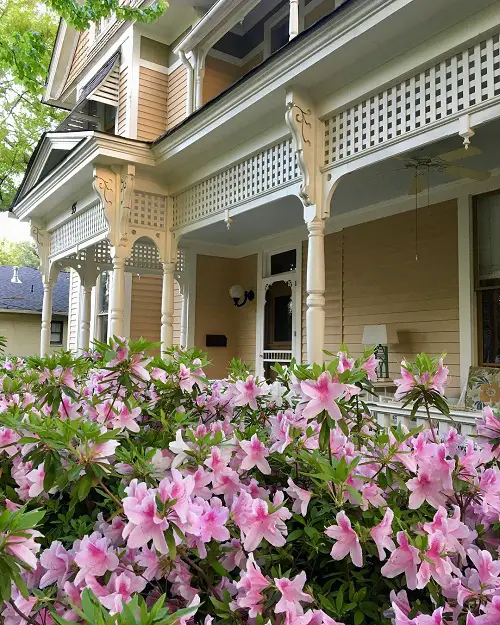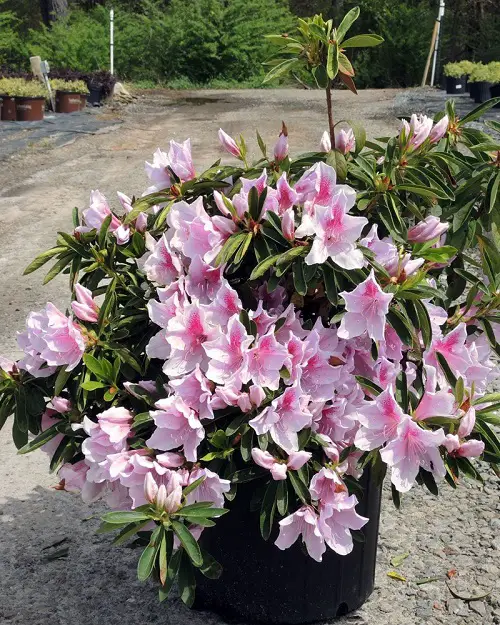George Taber Azalea offers clusters of large pink flowers that contrast beautifully with its deep green foliage.

What makes George Taber Azalea different from the other ones in this genus is the number of blooms it grows that look striking in any garden setting!
George Taber Azalea Information

Originating from the Rhododendron genus and part of the Ericaceae family, George Taber Azalea is native to regions of Asia, particularly China and Japan. However, it also thrives in various temperate climates and is popular in gardens across the United States.
What makes this different from other azaleas is the color transition. It starts with a light pink hue and gets a deeper pink spots as the flower matures, then fades into a white shade. This transformation of flowers is a stand out trait, which is not found in other azalea varieties!
Another aspect of this plant is its size and height, which can be about 6 to 8 feet, unlike any other azalea out there!
When it comes to flowering, these plants typically bloom in spring. In warmer regions, they can blossom as early as March and in cooler Northern areas, flowering may begin in April or May.
Botanical Name: Rhododendron ‘George Taber’
USDA Zones: 7-10
Best Container Size for George Taber Azalea
To grow George Taber Azaleas, pick a 14-18 inches wide and deep container. This will be good for a few years to come. As the plant grows and spreads, re-pot it into one size bigger pot than the old one, depending on how it thrives.
Propagating George Taber Azalea
Late spring to early summer is the apt time to propagate these flowers.
The best way to grow these plants is using cuttings. Simply, pick a healthy specimen and snip away a 5-7 inches long stem. Remove the lower leaves, dip the end in a rooting hormone, and plant in a well draining potting mix. Water well, and keep its pot where it can bask in indirect bright light all day long.
In about 6-8 weeks, the cuttings will form roots.
Requirements for Growing George Taber Azalea
Sunlight and Location
While growing flowering plants, we all know that they all love sunlight, but the intensity differs from plant to plant.
With George Taber Azaleas, you have to understand that the petals of its flowers are delicate, so they don’t appreciate harsh sunlight exposure, as it can scorch them.
So, the best location for these plants is any east facing spot—this way, they can enjoy the direct exposure of the mild morning sun, while being in bright indirect light for the rest of the day.
Growing Medium
The key to growing azaleas of any kind lies in the soil—it has to be on the acidic side, with good drainage and aeration. Here’s something you can make at home without spending much.
Add peat moss (40%) with pine bark fines (30%). Mix them well, and add perlite or vermiculite (20%) with Sand (10%). This will guarantees the best growth and flowers for George Taber Azaleas.
As these plants grow the best between a pH range of 4.5 and 6.0—you can pick any specialised azalea potting mixes that are designed to maintain this acidity level, too.
Water
These cultivars have shallow roots, which are more sensitive to water stress—daily watering the plant is a straight no. Moisten the growing medium when it goes dry to about an inch on the topsoil. Simple and effective!
Temperature
George Taber Azalea thrives in temperate climates, with an ideal temperature range of 18-32°C (65-90°F). These conditions promote optimal growth and flowering, while allowing the plant to flourish with blooms to its full potential.
The lowest temperature tolerance of the George Taber Azalea is around -10°C (14°F).
George Taber Azalea Care
Fertilizer
Don’t worry much about feeding these beauties, if you have used the mix we have suggested in the growing medium section. To boost flowering, any balanced liquid blend would do— just ensure to dilute it to 1/2 of its strength, and do not use it more than once in 3-4 weeks.
You can also go for a 10-5-4 blend, specially made for acid-loving plants. Just remember the dilution part!
You can also use coffee grounds (1 teaspoon per pot, per month). This is also the best way to make soil more acidic for these plants, something they love! Do get a pH meter for best results.
Pests and Diseases
Azaleas usually stay healthy and have good resistance to pests and diseases. However, keep an eye on aphids, spider mites, scale or whiteflies.
Diseases like powdery mildew, rust, leaf spot can all be prevented by avoiding overwatering and wetting the leaves.
Pruning
Taber Azaleas grow taller, wider, and denser than regular azaleas, and it is important to prune them from time to time in order to ensure the innermost parts get the right light and air penetration for better flowers.
After the plant flowers in spring, remove spent blooms, along with dead, diseased, and criss-cross branches. This will ensure the plant is ready for a fantastic flower display in the next blooming season!





